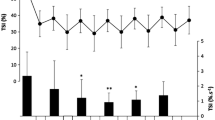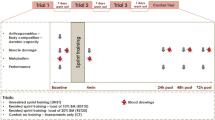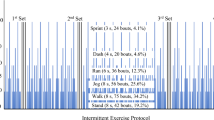Abstract
The aim of the present study was to examine the effect of an 8-week endurance training program on repeated-sprint (RS) performance and post-sprints muscle reoxygenation rate in 18 moderately trained males (34 ± 5 years). Maximal aerobic speed (MAS), 10 km running and RS (2 × 15-s shuttle-sprints, interspersed with 15 s of passive recovery) performance were assessed before and after the training intervention. Total distance covered (TD) and the percentage of distance decrement (%Dec) were calculated for RS. Between-sprints muscle reoxygenation rate (Reoxy rate) was assessed with near-infrared spectroscopy during RS before and after training. After training, MAS (+9.8 ± 5.8%, with 100% chances to observe a substantial improvement), 10 km time (−6.2 ± 5.3%, 99%), TD (+9.6 ± 7.7%, 98%), %Dec (−25.6 ± 73.6%, 93%) and Reoxy rate (+152.4 ± 308.1%, 95%) were improved. The improvement of Reoxy rate was largely correlated with improvements in MAS [r = 0.63 (90% CL, 0.31;−0.82)] and %Dec [r = −0.52 (−0.15;−0.76)]. Present findings confirm the beneficial effect of endurance training on post-sprint muscle reoxygenation rate, which is likely to participate in the improvement of repeated-sprint ability after training. These data also confirm the importance of aerobic conditioning in sports, where repeating high-intensity/maximal efforts within a short time-period are required.


Similar content being viewed by others
References
Balsom PD, Ekblom B, Sjodin B (1994a) Enhanced oxygen availability during high intensity intermittent exercise decreases anaerobic metabolite concentrations in blood. Acta Physiol Scand 150:455–456
Balsom PD, Gaitanos GC, Ekblom B, Sjodin B (1994b) Reduced oxygen availability during high intensity intermittent exercise impairs performance. Acta Physiol Scand 152:279–285
Billaut F, Basset FA, Falgairette G (2005) Muscle coordination changes during intermittent cycling sprints. Neurosci Lett 380:265–269
Bishop D, Edge J, Goodman C (2004) Muscle buffer capacity and aerobic fitness are associated with repeated-sprint ability in women. Eur J Appl Physiol 92:540–547
Bogdanis GC, Nevill ME, Boobis LH, Lakomy HK (1996) Contribution of phosphocreatine and aerobic metabolism to energy supply during repeated sprint exercise. J Appl Physiol 80:876–884
Bravo DF, Impellizzeri FM, Rampinini E, Castagna C, Bishop D, Wisloff U (2008) Sprint vs. interval training in football. Int J Sports Med 29:668–674
Buchheit M (2010). Performance and physiological responses to repeated-sprint and jump sequences. Eur J Appl Physiol Jul 30 [Epub ahead of print]
Buchheit M, Cormie P, Abbiss CR, Ahmaidi S, Nosaka KK, Laursen PB (2009a) Muscle deoxygenation during repeated sprint running: effect of active vs. passive recovery. Int J Sports Med 30:418–425
Buchheit M, Laursen PB, Ahmaidi S (2009b) Effect of prior exercise on pulmonary O2 uptake and estimated muscle capillary blood flow kinetics during moderate-intensity field running in men. J Appl Physiol 107:460–470
Buchheit M, Chivot A, Parouty J, Mercier D, Al Haddad H, Laursen PB, Ahmaidi S (2010a) Monitoring endurance running performance using cardiac parasympathetic function. Eur J Appl Physiol 108:1153–1167
Buchheit M, Mendez-Villanueva A, Delhomel G, Brughelli M, Ahmaidi S (2010b). Improving repeated sprint ability in young elite soccer players: repeated sprints vs. explosive strength training. J Strength Cond Res Mar 10 [Epub ahead of print]
Buchheit M, Mendez-Villanueva A, Quod MJ, Quesnel T, Ahmaidi S (2010c) Improving acceleration and repeated sprint ability in well-trained adolescent handball players: speed vs. sprint interval training. Int J Sports Physiol Perform 5:152–164
Buchheit M, Mendez-villanueva A, Simpson BM, Bourdon PC (2010d). Repeated-sprint sequences during youth soccer matches. Int J sport Med Jul 8. [Epub ahead of print]
Chance B, Dait MT, Zhang C, Hamaoka T, Hagerman F (1992) Recovery from exercise-induced desaturation in the quadriceps muscles of elite competitive rowers. Am J Physiol 262:C766–C775
Cohen J (1988) Statistical power analysis for the behavioral sciences. Lawrence Erlbaum, Hillsdale
Costes F, Prieur F, Feasson L, Geyssant A, Barthelemy JC, Denis C (2001) Influence of training on NIRS muscle oxygen saturation during submaximal exercise. Med Sci Sports Exerc 33:1484–1489
Dupont G, Moalla W, Guinhouya C, Ahmaidi S, Berthoin S (2004) Passive versus active recovery during high-intensity intermittent exercises. Med Sci Sports Exerc 36:302–308
Dupont G, Moalla W, Matran R, Berthoin S (2007) Effect of short recovery intensities on the performance during two Wingate tests. Med Sci Sports Exerc 39:1170–1176
Edge J, Bishop D, Goodman C, Dawson B (2005) Effects of high- and moderate-intensity training on metabolism and repeated sprints. Med Sci Sports Exerc 37:1975–1982
Enoka RM, Stuart DG (1992) Neurobiology of muscle fatigue. J Appl Physiol 72:1631–1648
Gibala MJ, Little JP, van Essen M, Wilkin GP, Burgomaster KA, Safdar A, Raha S, Tarnopolsky MA (2006) Short-term sprint interval versus traditional endurance training: similar initial adaptations in human skeletal muscle and exercise performance. J Physiol 575:901–911
Glaister M (2005) Multiple sprint work: physiological responses, mechanisms of fatigue and the influence of aerobic fitness. Sports Med 35:757–777
Glaister M, Stone MH, Stewart AM, Hughes M, Moir GL (2004) The reliability and validity of fatigue measures during short-duration maximal-intensity intermittent cycling. J Strength Cond Res 18:459–462
Glaister M, Stone MH, Stewart AM, Hughes MG, Moir GL (2007) The influence of endurance training on multiple sprint cycling performance. J Strength Cond Res 21:606–612
Hamaoka T, Iwane H, Shimomitsu T, Katsumura T, Murase N, Nishio S, Osada T, Kurosawa Y, Chance B (1996) Noninvasive measures of oxidative metabolism on working human muscles by near-infrared spectroscopy. J Appl Physiol 81:1410–1417
Hopkins WG, Marshall SW, Batterham AM, Hanin J (2009) Progressive statistics for studies in sports medicine and exercise science. Med Sci Sports Exerc 41:3–13
Ichimura S, Murase N, Osada T, Kime R, Homma T, Ueda C, Nagasawa T, Motobe M, Hamaoka T, Katsumura T (2006) Age and activity status affect muscle reoxygenation time after maximal cycling exercise. Med Sci Sports Exerc 38:1277–1281
Kime R, Hamaoka T, Sako T, Murakami M, Homma T, Katsumura T, Chance B (2003a) Delayed reoxygenation after maximal isometric handgrip exercise in high oxidative capacity muscle. Eur J Appl Physiol 89:34–41
Kime R, Karlsen T, Nioka S, Lech G, Madsen O, Saeterdal R, Im J, Chance B, Stray-Gundersen J (2003b) Discrepancy between cardiorespiratory system and skeletal muscle in elite cyclists after hypoxic training. Dyn Med 2:4
McCully KK, Iotti S, Kendrick K, Wang Z, Posner JD, Leigh J Jr, Chance B (1994) Simultaneous in vivo measurements of HbO2 saturation and PCr kinetics after exercise in normal humans. J Appl Physiol 77:5–10
Mendez-Villanueva A, Hamer P, Bishop D (2007) Fatigue responses during repeated sprints matched for initial mechanical output. Med Sci Sports Exerc 39:2219–2225
Mohr M, Krustrup P, Nielsen JJ, Nybo L, Rasmussen MK, Juel C, Bangsbo J (2007) Effect of two different intense training regimens on skeletal muscle ion transport proteins and fatigue development. Am J Physiol Regul Integr Comp Physiol 292:R1594–R1602
Oliver JL (2009) Is a fatigue index a worthwhile measure of repeated sprint ability? J Sci Med Sport 12:20–23
Puente-Maestu L, Tena T, Trascasa C, Perez-Parra J, Godoy R, Garcia MJ, Stringer WW (2003) Training improves muscle oxidative capacity and oxygenation recovery kinetics in patients with chronic obstructive pulmonary disease. Eur J Appl Physiol 88:580–587
Pyne DB, Saunders PU, Montgomery PG, Hewitt AJ, Sheehan K (2008) Relationships between repeated sprint testing, speed, and endurance. J Strength Cond Res 22:1633–1637
Smith KJ, Billaut F (2010) Influence of cerebral and muscle oxygenation on repeated-sprint ability. Eur J Appl Physiol 109:989–999
Spencer M, Lawrence S, Rechichi C, Bishop D, Dawson B, Goodman C (2004) Time-motion analysis of elite field hockey, with special reference to repeated-sprint activity. J Sports Sci 22:843–850
Wolf M, Ferrari M, Quaresima V (2007) Progress of near-infrared spectroscopy and topography for brain and muscle clinical applications. J Biomed Opt 12:062104
Acknowledgments
The authors thank Arnaud Chivot and Jonathan Parouty for their great help in data collection, Irmant Cadjjiov for his help during the writing of the manuscript and all the participants for their enthusiastic participation.
Author information
Authors and Affiliations
Corresponding author
Additional information
Communicated by Susan Ward.
Rights and permissions
About this article
Cite this article
Buchheit, M., Ufland, P. Effect of endurance training on performance and muscle reoxygenation rate during repeated-sprint running. Eur J Appl Physiol 111, 293–301 (2011). https://doi.org/10.1007/s00421-010-1654-9
Accepted:
Published:
Issue Date:
DOI: https://doi.org/10.1007/s00421-010-1654-9




